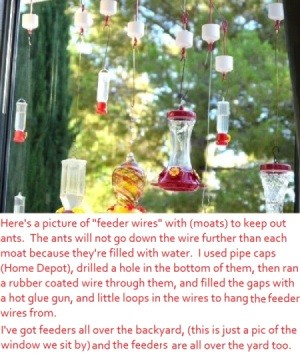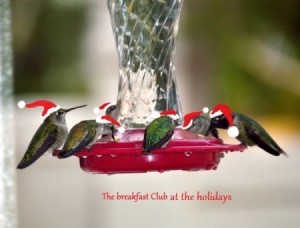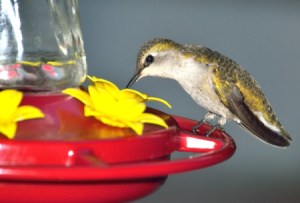 I have been reading about a variety of ideas for keeping ants, etc., out of hummingbird feeders. I have cared for hummingbirds for over 30 years and I've tried just about everything out there.
I have been reading about a variety of ideas for keeping ants, etc., out of hummingbird feeders. I have cared for hummingbirds for over 30 years and I've tried just about everything out there.
I have two of the very largest Perky Pet Hummingbird feeders made. Each year we end up with between 20 to 30 hummingbirds. The best things we've done is to hang the feeders from the eaves of the house with a pully that allows me to raise and lower the feeders to change their feed, which is at least once a day in each. To get to the wire that the feeders hang from, first the ants have to climb across our brick wall and up the drain spout to get to the point from which the feeders hang. From there, they can climb down. But I beat them to the punch by dusting the wall and the drain spout with Sevin Dust. I don't like killing the ants, but they seem to get the point after a while and don't bother the feeders anymore after that.
Flying insects, especially wasps, are a different matter. Since one of my feeders hangs in front of my kitchen window, I have a good view of them. As soon as I see one buzzing around the feeder, I go outside with a flyswatter.
Keep all sorts of poisons, and other deterents, like oils, etc., away from the feeders and their hangers. My birds perch on the lines, as well as the cord the hangers hang from while waiting their turn to the feeders. Anything they pick up on their little feet can easly wind up in their beaks, or be carried back to the little ones in the nests.
Add your voice! Click below to comment. ThriftyFun is powered by your wisdom!
As far as ants go, and they do, I have my feeder hanging on a
Shepherd's hook. My husband wrapped a piece of double-sided tape around the pole and the ants are not able to cross it.
Use a little vaseline, in place of the tape, it works great
My granny put a big glob of Vaseline on the wire holding her feeder no ants can crawl thru it works prefect
Vaseline isn't good to use around hummers because it can get on their feathers & affect their ability to fly.
I have kept bees and wasps away from the hummer feeders for years by applying mint extract from the cooking section at the local grocer. I dip a Qtip in the flavoring and dab it around the feeder port's bottoms, when the feeder comes apart for cleaning and on the ports of the feeders as well.
Actually the death rate of honeybees is such that you should be feeding bees more than humingbirds. 80% of the plants we eat depend on pollination by bees to survive. How about multiplying the feeders or hanging fruits for bees and wasps, like pears or apples or other juicy fruits and most of all planting flowers that bees love and of course stop using pesticides. Be informed of the situation of the bees here :
www.theguardian.com/
and learn to help pollinators here : millionpollinatorgardens.org/
Hope this help the bees !
I have no problem with ants, only bees. I have found that kill a bee and more bees will come as they are attracted more so to the scent of fallen brother.
There are ways to keeps flying insects from ,including bees from feeders. I have hummers and lessened bee intrusion by providing bees with their own well placed feeding stations.
Hi fellow "birder". I sure understand your problem.
I haven't had an ant problem in years (since I put up the ant moats). This will eliminate your ants from ever getting to your
hummingbird feeders, ever again.
As for the bees, your picture looks like mine, before I realized these little feeders (I have four of them) like yours here, they
drip. You need feeders with the port holes facing upwards,
so the bees, wasps, nothing, then can find anything to eat and
then they leave.
I'll take a picture and post it so you can see what I call "flat feeders" which will not allow bees to eat from them so they go
After the bees leave, which usually takes about 4 days, because they'll keep checking on the feeders for a few days first, then when they realize there's nothing, they go - then that's when you can hang out your little 4oz feeders again, and your hummers will be happy!

I hope you get a kick out of this picture!
In "paints on the computer" I'd drawn little Santa hats on our little
guys, as they all sat there and ate at this one particular feeder-and I called them the "Breakfast Club".
It was raining outside that day and I've noticed over the years that when it rains, the hummingbirds seem to be in a very sharing mood towards each other, as usually, they want each feeder to themselves.
This is what I call a "flat feeder" as the port holes for them to drink, faces upwards. Any feeder like this, where the holes aren't on the side of the feeder, won't drip, and the bees cannot get anything to eat, so they leave in less than a week (for good), or
until the next year.
After the bees are gone, (since they can't get any food/nectar), then I put my little feeders back out again, since the hummers love those little 4 ounce'ers so much.
Both pictures I've posted, if you click on the pic, it will enlarge.

Here's another with the port holes facing upwards.
These type of feeders will not, and cannot drip.
Bees and wasps cannot get anything out of them which is
why they leave, then the hummers can enjoy again.

The insects on your pictures are not wasps but bees.
Very useful insects helping every flower to turn into a fruit.
Very endangered species.
Insect envolved in the growing and fructification of everything you eat ! Protect the bees !
Ants : only insect able to fight termites. Remember this when the wood structure of your house will collapse.
Add your voice! Click below to comment. ThriftyFun is powered by your wisdom!